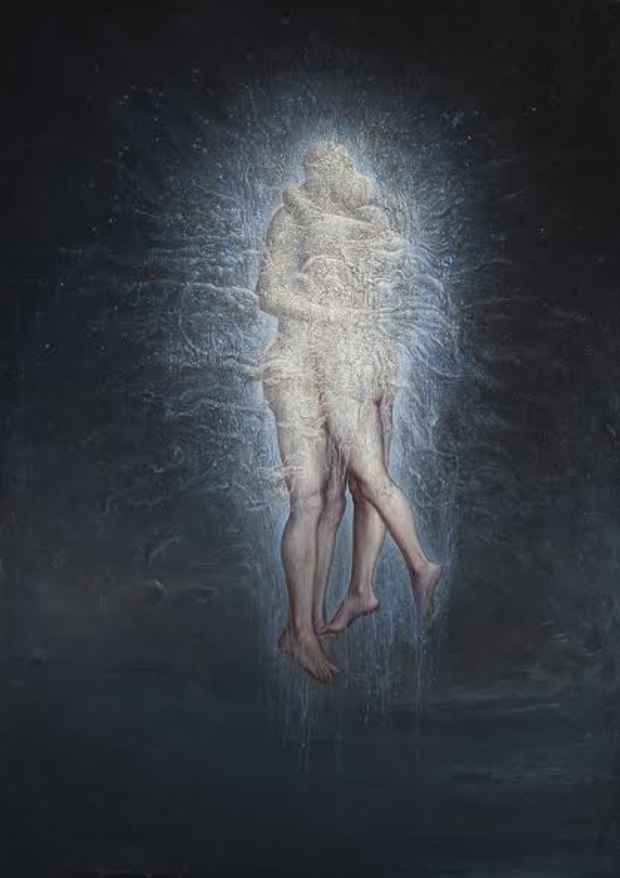Agostino Arrivabene “Hierogamy”
Cara Gallery

[Image: Agostino Arrivabene "Sacrum Facere" (2016) Oil on Linen, 75x53 in.]
This event has ended.
Cara Gallery presents Agostino Arrivabene’s first solo exhibition in New York - Hierogamy
The itinerary, put in place by Agostino Arrivabene for his Hierogamy exhibition, denotes the arrival point of a personal and artistic journey that is unique and original, yet at the same time universal. The artist draws from his entire patrimony of shapes and codes to create, through his canvasses, a truly alchemical act that makes the surfaces burst into song, creating a chant that can unite dissimilar notes and turn them into a symphony.
To create his personal “Lapis Philosophorum” (Philospher’s stone), in addition to the dialogue between the hermetic images of Alchemical Art and the archaic, past languages of European Art, Arrivabene has undertaken candid incursions into G.B. Piranesi’s prints of Ancient Rome and into American Art of the 19th century, through the captivating and suggestive romantic landscapes of the Hudson River School art movement.
Arrivabene’s approach to painting stems from his artistic influences Gustave Moreau and Odd Nerdrum. He follows traditional methods that include grinding his own pigments and the almost forgotten technique of mischtechnik. In mischtechnik, egg tempera is used in combination with oil-based paints to create translucent layers which, when laid over each other, refract light creating a sense of luminosity. This attention to the minutiae has resulted in Arrivabene’s paintings actually embodying a process of alchemical transformation, in which the physical matter of painting itself is transmuted into extraordinary light-filled visions.
Investigating eternity, time, the process of change, the rites of transformation, and sacred love and death, Arrivabene utilizes symbols and images that are seemingly distant from the contemporary in order to create art that verges on the philosophical, sociological and even spiritual era. These expressive realities become a form of bulimic nourishment for the artist and are manifested in continuous leitmotifs, or rather “leit-fossils” as French philosopher and art historian, G.D. Huberman would say. The “ethical” quality of his modus operandi turns colors, shapes, symbols and analogical references into the foundations of an artistic event that is not an abstraction from reality, but rather a link to his personal intimacy and to the collectiveness that surrounds him.
The title of the exhibition is therefore not surprising. Hierogamy recalls the Alchemic myth of the Hermaphrodite, namely the being that encapsulates all, an entity that encompasses everything. To symbolize this amalgamation the artist adopts the amorous encounter, which reaches its apex in the poignant canvas Sacrum Facere (2016). Ultimately, union is sacred because it entails sacrifice, implying the act of doing something sacred. The harmonious union between humans, creatures, and nature often represented and contextualized in infinite landscapes.
The exhibition takes its point of departure with two important paintings carried out between 2014 and 2016 (Ea -Exit and The Dream of Asclepius) and brings together works created in varying pictorial techniques - oil on canvas or wood, cracked oil on brass, and painting on stone according to the ancient Wunderkammer tradition. Ea-Exit (2015) is the almost conclusive embodiment of a cycle dedicated to the sacred Eleusinian mysteries that have obsessed Arrivabene since 2010, and about which he has created a vast body of work.
These flashes of light in the paintings on display in the first room anticipate another piece of work, recently completed especially for this exhibition: Cauda Pavonis (2016). This painting of many colors is an expression of renewal; it is the arc in the sky through which the sacred couple rises up from the earth to the above after their Hierogamic union. The landscape in which their union is sealed is once again the same golden cloud that becomes the echo of Arrivabene’s clouds, the mere presences and absences, the casings that conceal and reveal the divinity.
With this painting, Cauda Pavonis, Arrivabene suggests the enigma of the amorous and mystical pairing between male and female, light and dark and between the vibrant crudity and characteristic velvetiness of Renaissance paintings. It is no coincidence that Arrivabene’s undisputed beacons are 15th century artists Leonardo da Vinci and Ercole de’ Roberti, artists who, during the Renaissance, both explored man as a microcosm placed within a macrocosm.
By contrast, the painting The Dream of Asclepius (2015) becomes an emblem of the horrendous nutriment for earth; a man vacillating between sleep and death is devoured by the soil and becomes, in turn, the root or sacred support for new paradoxical arboreal structures. The landscape in this painting recalls the one of the Madonna in Porto Altarpiece, by Ercole de’ Roberti – now preserved in the Brera museum in Milan – which expands onto the huge canvas beside it creating a new romantic vision of the panoramic space that collects these insane beings, hybrids made of flesh, skin, and vegetation.
Media
Schedule
from March 04, 2016 to April 23, 2016
Opening Reception on 2016-03-03 from 18:00 to 20:00